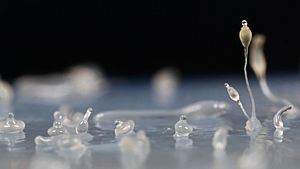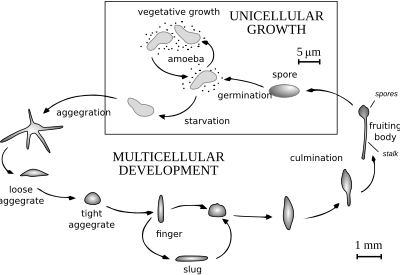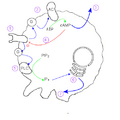Dictyostelid facts for kids
Quick facts for kids Dictyostelids |
|
|---|---|
 |
|
| Dictyostelium discoideum | |
| Scientific classification |
|
| Domain: | Eukaryota |
| Phylum: | Amoebozoa |
| Infraphylum: | Mycetozoa |
| Class: | Dictyostelia Lister 1909, emend. Olive 1970 |
| Order: | Dictyosteliida |
| Families & genera | |
|
Dictyosteliidae |
|

Dictyostelids are a special group of tiny living things called slime molds. You can also think of them as "social amoebas". They are quite unusual because they are eukaryotes, meaning their cells have a nucleus. For most of their lives, they live as single, separate cells. But when times get tough, like when there's no food, they gather together to form a bigger, multi-celled body that helps them reproduce.
This body makes tiny spores that have strong protective walls. These spores can wait until conditions are better, then they open up and become new single cells. This means dictyostelids are both single-celled and multi-celled at different times!
When they are separate amoebae, they eat and divide like normal cells. They mostly munch on soil bacteria. If their food runs out, they come together to form a kind of slug-like shape. This "slug" has a clear front and back. It can sense light and temperature, and it can move around. When the conditions are just right, the slug changes into a fruiting body. This body has a stalk that holds up one or more balls of spores. These spores are inactive cells with tough walls. They will become new amoebae when there is enough food again.
Scientists often use Dictyostelium as a model organism in molecular biology and genetics. They study it to learn about how cells talk to each other (called cell communication), how cells become different types (called differentiation), and how cells can be programmed to die (called apoptosis). You can find a lot of research about Dictyostelium online at dictyBase.
Contents
How Dictyostelium Cells Gather
The way these amoebae gather together depends on a special signal molecule. When a cell is stressed, perhaps because there's no food, it starts to release this signal. Other nearby amoebae detect the signal and react in two main ways:
- The amoeba starts moving towards the signal.
- The amoeba also starts releasing more of the signal itself.
This creates a chain reaction, passing the signal through all the nearby amoebae. They all move towards the area where the signal is strongest, forming a group.
Discovery and Classification
Dictyostelids were first found in a North Carolina forest in 1935. The specific type, Dictyostelium discoideum, was first thought to be a type of 'lower fungi'. Later, it was placed in the kingdoms Protista and Fungi. By the 1990s, most scientists agreed on how they are classified today.
Today, amoebozoa, which include dictyostelids, are seen as their own major group, or clade. They are actually more closely related to animals and fungi than they are to plants.
The Dictyostelium Genome
The complete genome (all the genetic information) of Dictyostelium discoideum was published in the science journal Nature in 2005. Its haploid genome has about 12,500 genes spread across six chromosomes. To give you an idea, the human genome has about 20,000 to 25,000 genes on 23 pairs of chromosomes.
Images for kids
See also
 In Spanish: Dictyostelea para niños
In Spanish: Dictyostelea para niños



